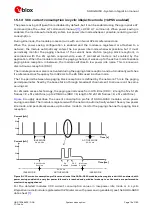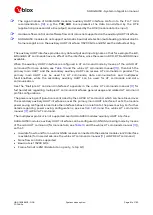
SARA-G450 - System integration manual
UBX-18046432 - R08
System description
Page 33 of 143
C1-Public
If AT+UPSV=2 is set and hardware flow control is disabled, the module monitors the RTS line to
manage the power saving configuration:
When an OFF-to-ON transition occurs on the RTS input line, the UART is enabled and the module
wakes up to active mode: after ~20 ms from the OFF-to-ON transition, the UART / module wake-up
is completed and data can be received without loss. The module cannot enter the low power idle
mode and the UART is kept enabled as long as the RTS input line is held in the ON state
If the RTS input line is set to the OFF state by the DTE, the UART is disabled (held in low power
mode) and the module automatically enters low power idle mode whenever possible
For more details, see section
and the u-blox AT commands manual
, AT+UPSV command.
DSR signal behavior
If AT&S1 is set, as it is by default, the DSR module output line is set by default to the OFF state (high
level) at UART initialization. The DSR line is then set to the OFF state when the module is in command
mode or in online command mode and is set to the ON state when the module is in data mode (see the
u-blox AT commands manual
for the definition of the interface data mode, command mode and
online command mode).
If AT&S0 is set, the DSR module output line is set by default to the ON state (low level) at UART
initialization and is then always held in the ON state.
DTR signal behavior
The DTR module input line is set by default to the OFF state (high level) at UART initialization. The
module then holds the DTR line in the OFF state if the line is not activated by the DTE: an active pull-up
is enabled inside the module on the DTR input.
Module behavior according to DTR status can be changed by AT command (for more details, see the
u-blox AT commands manual
, AT&D command description).
DCD signal behavior
If AT&C1 is set, as it is by default, the DCD module output line is set by default to the OFF state (high
level) at UART initialization. The module then sets the DCD line according to the carrier detect status:
ON if the carrier is detected, OFF otherwise. For voice calls, DCD is set to the ON state when the call
is established. For a data call, there is the following scenario (see the u-blox AT commands manual
for the definition of the interface data mode, command mode and online command mode):
Packet Switched Data call: Before activating the PPP protocol (data mode) a dial-up application must
provide the ATD*99***<context_number># to the module: with this command the module switches
from command mode to data mode and can accept PPP packets. The module sets the DCD line to the
ON state, then answers with a CONNECT to confirm the ATD*99 command. The DCD ON is not related
to the context activation but with the data mode
☞
The DCD is set to ON during the execution of the +CMGS, +CMGW, +USOWR, +USODL AT
commands requiring input data from the DTE: the DCD line is set to the ON state as soon as the
switch to binary/text input mode is completed and the prompt is issued; DCD line is set to OFF as
soon as the input mode is interrupted or completed (for more details, see the u-blox AT commands
manual
☞
The DCD line is kept in the ON state, even during the online command mode, to indicate that the
call is established, while if the module enters command mode, the DSR line is set to the OFF state.
For more details, see



































